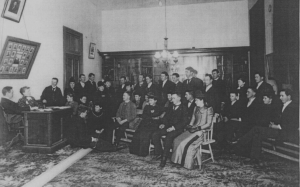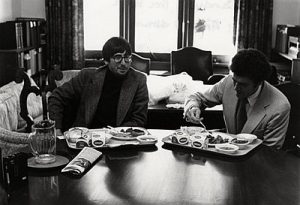Behind the Scenes: “Animal House” at 40
In the fall of 1977, John Landis and his Universal Pictures production crew came to Eugene, Oregon, to begin filming their college comedy Animal House on the campus of the University of Oregon. They recruited dozens of UO students as extras, and used many well-known campus buildings and landmarks as locations. The video above is a compilation of behind-the-scenes footage shot by local TV news crews, including the iconic parade scene shot in Cottage Grove, Oregon, as well as the demolition of the Delta house in the early 1980s. The news footage all comes from the KEZI-TV/Chambers Communications Corp. records (Coll 427), and the still images come from University Archives Photographs (UA Ref 3) in Special Collections & University Archives (SCUA).
Some of this same footage, plus additional clips and images from SCUA, is also available in a related video produced by the University of Oregon’s Communications & Marketing department to commemorate the 40th anniversary of the the film’s release. An article in the summer 2018 issue of the Oregon Quarterly explores the film’s local history and its ongoing impact as a cult favorite.
Both videos demonstrate how archival footage can be combined in different ways and recontextualized to tell new stories about history.
As a student delving into this archival collection of behind-the-scenes footage and outtakes, this project felt transportive as I immersed myself in images from the past forty years. It was also a learning experience in the context of the culture of UO, as well as the evolution of what we deem as socially responsible in relation to comedy. Archival video footage and images are unique in their ability to present the viewer with a view of the world as it used to be, which can lead to greater understanding of how the past influenced the present.
You don’t need to be a student at the University of Oregon to find something in KEZI-TV news collection to connect with. Parents, alumni, faculty members, fans of the movie, and all types of Eugenians will come across familiar sites as they stood forty years ago. From downtown Cottage Grove run amok to John Belushi finagling a horse through Johnson Hall, this collection provides us with a vision of our campus and the surrounding area through a retro, Hollywood lens.
For me, the image of Belushi playing his guitar in a booth at the EMU fishbowl resonates strongly. To see a Hollywood star sitting by the same windows many of us have gazed through while working on a project or getting lunch with friends makes the connection between then and now all the more palpable.
Of course, the film isn’t without certain problematic tendencies. While I’m not excusing the myriad punchlines that come at the expense of a variety of social communities, I will say that this archive is a fun look into the loose atmosphere of the film set. Furthermore, this film still serves as the largest vehicle for the city of Eugene’s representation in Hollywood lore, as it grossed over $140 million and spawned an entire generation of knock-offs. Because of this, our archival collections serve as an important look into the creation of Eugene and the University of Oregon’s Hollywood immortality.
Local celebrations will peak in August when Cottage Grove hosts a 40th anniversary parade, toga party, film screening, and other festivities. The historic Hollywood Theatre in Portland will screen a 35mm print of the film on August 17.
–Michael O’Ryan, Curatorial Assistant




